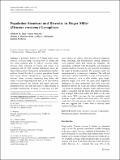Population structure and diversity in finger millet (Eleusine coracana) germplasm
Publication Date
2008-05-01Author
Mathews M Dida, Nelson Wanyera, Melanie L Harrison Dunn, Jeffrey L Bennetzen, Katrien M Devos
Metadata
Show full item recordAbstract/
A genotypic analysis of 79 finger millet accessions (E. coracana subsp. coracana) from 11 African and five Asian countries, plus 14 wild E. coracana subsp. africana lines collected in Uganda and Kenya was conducted with 45 SSR markers distributed across the finger millet genome. Phylogenetic and population structure analyses showed that the E. coracana germplasm formed three largely distinct subpopulations, representing subsp. africana, subsp. coracana originating from Africa and subsp. coracana originating from Asia. A few lines showed admixture between the African and Asian cultivated germplasm pools and were the result of either targeted or accidental intercrossing. Evidence of gene flow was also seen between the African wild and cultivated subpopulations, indicating that hybridizations among subspecies occur naturally where both species are sympatric. The genotyping, combined with phylogenetic and population structure analyses proved to be very powerful in predicting the origin of breeding materials. The genotypic study was complemented by a phenotypic evaluation. The wild and cultivated accessions differed by a range of domestication-related characters, such as tiller number, plant height, peduncle length, seed color and grain yield. Significant differences in plant architecture and yield were also identified between the Asian and African subpopulations. The observed population structure within cultivated finger millet is consistent with the theory that, after the introduction of finger millet from Africa into India via the trade routes some 3000 years ago, the two germplasm pools remained largely isolated until recent times. The significantly lower diversity present within the Asian subpopulation also suggests that it arose from a relatively small number of founder plants.

